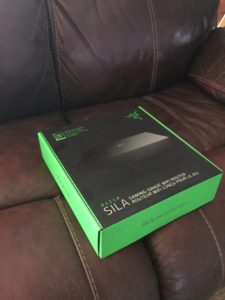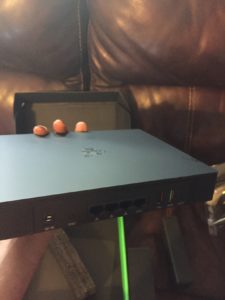Review of the Razer Sila Gaming Wifi Router 10/16/2018
By: Harlan T Beverly, PhD, MBA, BSEE
tldr; The Razer Sila is the best gaming router I have ever tested, and I have tested more than a dozen. In fact, I actually designed and built my own router, and even founded a gaming network hardware company. The only thing wrong with this router is that it does take a bit of tweaking to get it setup correctly. Disclaimer, this router was sent to me for free as an evaluation unit from Razer, with final firmware.

The Razer Sila gaming router is an incredible piece of hardware. It is not just an excellent home router, sporting 3 Gigabit LAN ports and 1 Gigabit WAN port, but it also provides 2.4Ghz wifi and two (2) 5Ghz wifi channels. It also sports the ability to pair with other Razer Sila’s to extend your network coverage and uses it’s extra 5Ghz wifi channel to do this (if needed). What truly makes the Razer Sila special though are its two Quality of Service (QoS) features: Razer FasTrack and Gaming Mode. These QoS features claim to be able to help manage your internet and prevent others who use your internet from causing you lag (latency spikes) in games.
First, a bit about range. I tested both the 2.4 Ghz and 5 Ghz wifi range and in my opinion the Razer Sila has an excellent range. It seems to be superior by about 20% in range over my other two gaming routers from other companies (Linksys and Netgear). I tested this by leaving my house with my phone and tablet and noticing when signal dropped to where I lost internet. It was crazy that I was able to get more than 50 feet from my home, where the router was inside, just a great range.
 Second, a bit about the install process. Opening the box was quite nice. Everything was arranged nicely and simply, and had the classic Razer finish (soft feeling black plastic). I was surprised that there were no antennas to attach, but then I read that they were arranged inside the case for optimal range (and I confirm that is the case). Plugging it in was easy, and hooking it to my WAN and LAN was, click, click. My unit had a red colored Razer symbol, but in the manual it said it would be red if no WAN. I was impatient and hit the reset button, but I suspect I could have waited and it would come on. Anyways, after my reset, it came on fine and was blinking purple, meaning downloading latest firmware. It was green and working after that, and I was already back online on my desktop which was connected to a LAN port.
Second, a bit about the install process. Opening the box was quite nice. Everything was arranged nicely and simply, and had the classic Razer finish (soft feeling black plastic). I was surprised that there were no antennas to attach, but then I read that they were arranged inside the case for optimal range (and I confirm that is the case). Plugging it in was easy, and hooking it to my WAN and LAN was, click, click. My unit had a red colored Razer symbol, but in the manual it said it would be red if no WAN. I was impatient and hit the reset button, but I suspect I could have waited and it would come on. Anyways, after my reset, it came on fine and was blinking purple, meaning downloading latest firmware. It was green and working after that, and I was already back online on my desktop which was connected to a LAN port.
Third, a bit about the setup process. Basic setup was easy. All I had to do was install the Razer app on my phone. I could also have setup the device using the 192.168.8.1 web UI, but I wanted to try the phone app. It was easy and guided me through naming my wifi. One nice feature is that it also scanned my wifi for the cleanest channels and automatically chose them. After that, I was online with my wifi devices as well. From here, it was a bit more challenging. It asked me if I wanted to enable QoS. I chose yes and it had me run a speed test. My speed test was not very accurate, so I ran it again. Finally it got numbers I expected, and I proceed to switch on FasTrack and Gaming Mode. I only wish it had run these tests by itself and automatically enabled these features because they are what makes the router special.

Now on to performance testing. I didn’t actually bother testing throughput, as for gaming, I don’t really care. I’m sure it can get at least 50% of theoretical bandwidth, and it’s more than I would ever need. Instead, I focused on latency testing in gaming in a variety of conditions. It is worth noting that I live in the country and have terrible bandwidth problems, especially at night. I also have a family that seems to suck up internet like sponge. I really need a gaming router to deliver or I can’t really game at all. The good news is it works! I immediately saw my ping drop by 20ms, from ‘unplayable 100ms’ to ‘mostly playable 80ms’. Then, I had my family do their worst… streaming Youtube, Netflix, and downloading files… nothing could shake my 80-90ms ping, whereas normally my ping would spike up to 200ms. This is exactly how QoS is supposed to work! Everything was butter until about 8pm. At 8pm is when my neighbors (all on the same Internet Service Provider (ISP)) started using the internet heavily. It was at this point that the router’s main problem surfaced. There was no way to re-run that speed test from the Web UI. What’s more, it really should be running a speed test every few hours as internet conditions change over time. Luckily I was able to hand-enter new bandwidth numbers to restrict my bandwidth further and get the performance I needed to game. The next day I had to hand-edit my bandwidth back up so my family could watch videos while I game, and back and forth. This lack of auto-running bandwidth speedtest is not exclusive to Razer, all the brands fail to do this right. I’m hopeful that Razer might implement a fix or setting for this in the future. The key is though, that the Razer Sila’s QoS system ACTUALLY WORKS! This is not true of the other gaming routers I have tested, including the top two from Netgear and Linksys. For those brands, I am forced to delete the firmware it comes with and install OpenWRT (Linux router project) and setup my own QoS using Linux skills. For the Razer Sila, I don’t need to do this at all.
It just works!
Darn near perfectly.

